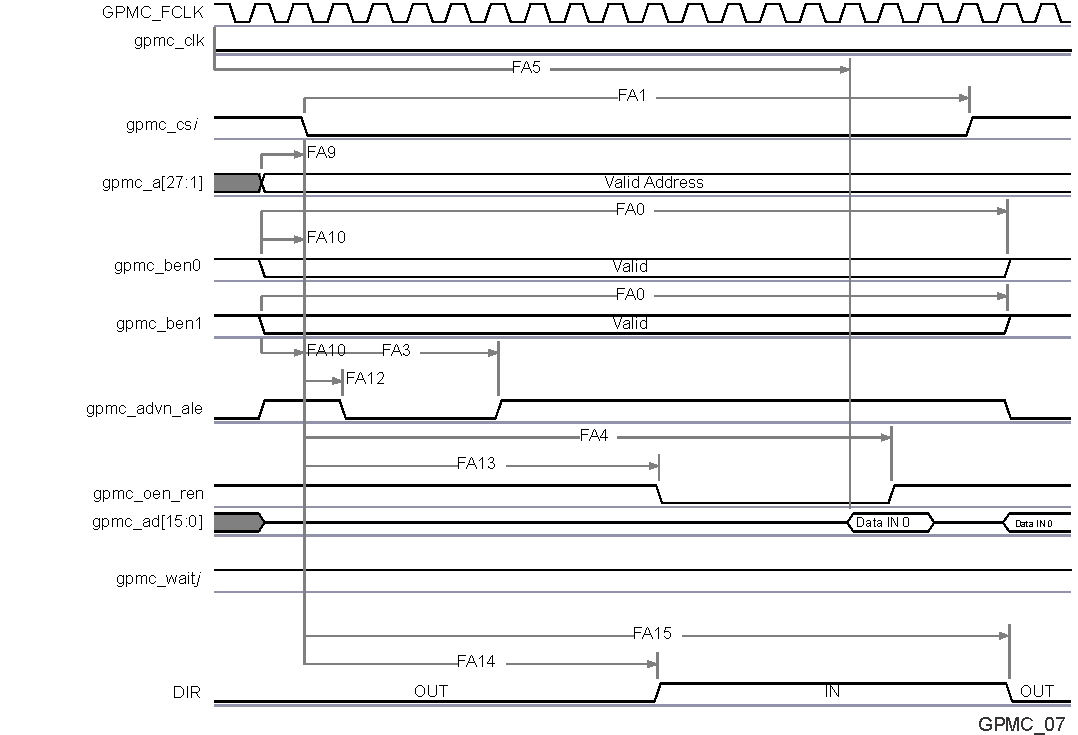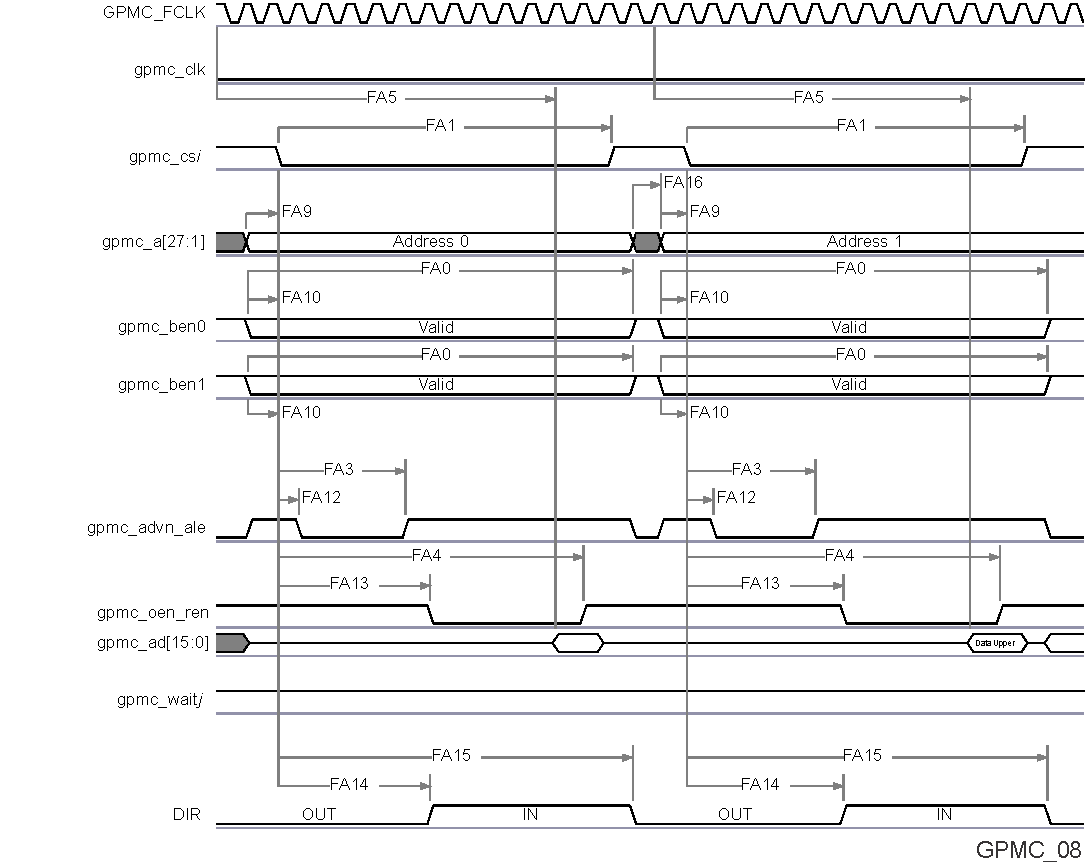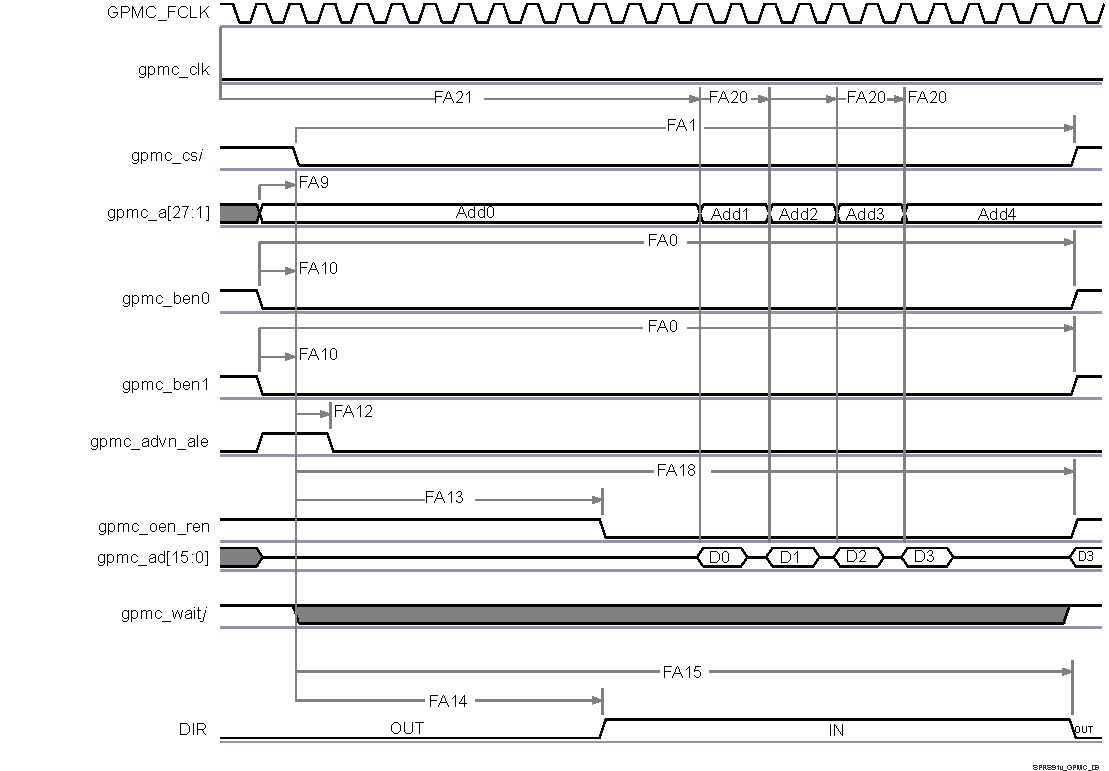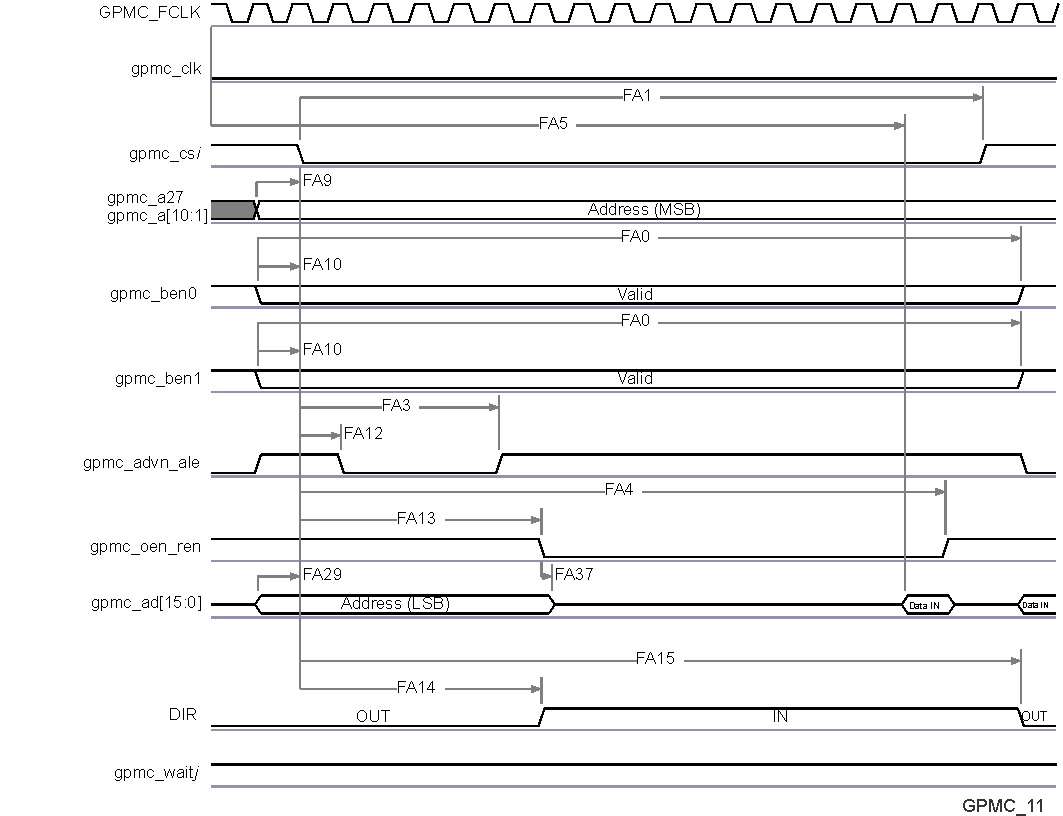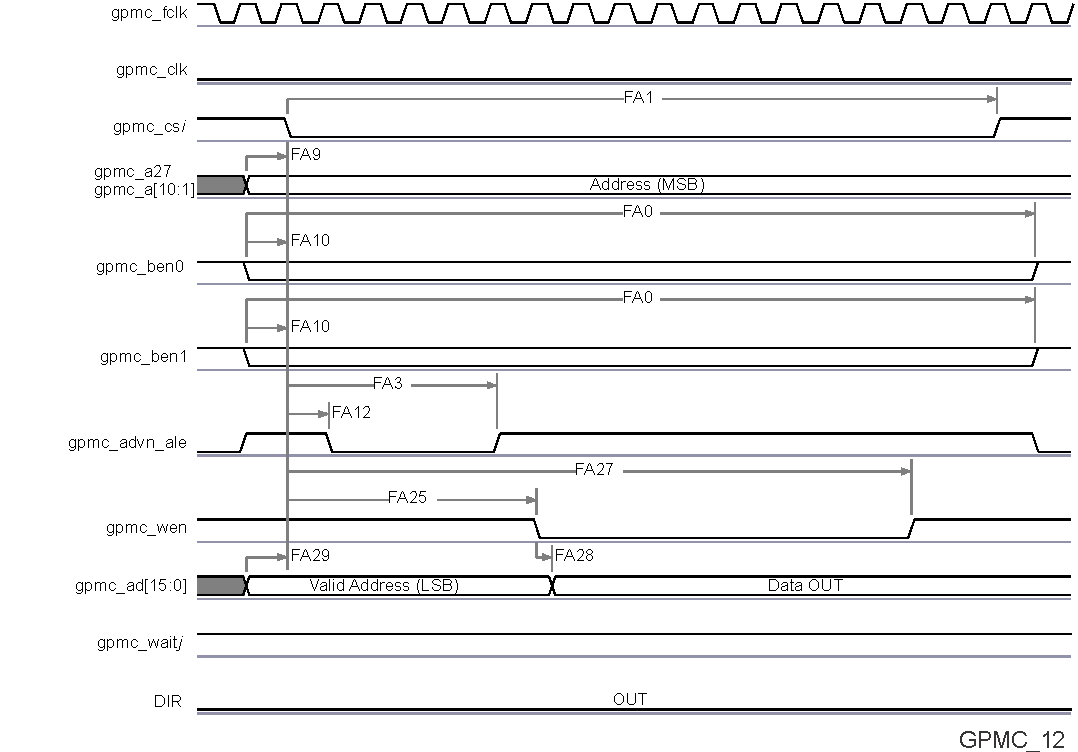SPRS951F December 2015 – May 2019 TDA2HF , TDA2HG , TDA2HV , TDA2LF , TDA2SA , TDA2SG , TDA2SX
PRODUCTION DATA.
- 1 Device Overview
- 2 Revision History
- 3 Device Comparison
-
4 Terminal Configuration and Functions
- 4.1 Terminal Assignment
- 4.2 Ball Characteristics
- 4.3 Multiplexing Characteristics
- 4.4
Signal Descriptions
- 4.4.1 Video Input Port (VIP)
- 4.4.2 Display Subsystem – Video Output Ports
- 4.4.3 Display Subsystem – High-Definition Multimedia Interface (HDMI)
- 4.4.4 External Memory Interface (EMIF)
- 4.4.5 General-Purpose Memory Controller (GPMC)
- 4.4.6 Timers
- 4.4.7 Inter-Integrated Circuit Interface (I2C)
- 4.4.8 Universal Asynchronous Receiver Transmitter (UART)
- 4.4.9 Multichannel Serial Peripheral Interface (McSPI)
- 4.4.10 Quad Serial Peripheral Interface (QSPI)
- 4.4.11 Multichannel Audio Serial Port (McASP)
- 4.4.12 Universal Serial Bus (USB)
- 4.4.13 SATA
- 4.4.14 Peripheral Component Interconnect Express (PCIe)
- 4.4.15 Controller Area Network Interface (DCAN)
- 4.4.16 Ethernet Interface (GMAC_SW)
- 4.4.17 eMMC/SD/SDIO
- 4.4.18 General-Purpose Interface (GPIO)
- 4.4.19 Pulse Width Modulation (PWM) Interface
- 4.4.20 System and Miscellaneous
- 4.4.21 Test Interfaces
-
5 Specifications
- 5.1 Absolute Maximum Ratings
- 5.2 ESD Ratings
- 5.3 Power on Hour (POH) Limits
- 5.4 Recommended Operating Conditions
- 5.5 Operating Performance Points
- 5.6 Power Consumption Summary
- 5.7
Electrical Characteristics
- 5.7.1 LVCMOS DDR DC Electrical Characteristics
- 5.7.2 HDMIPHY DC Electrical Characteristics
- 5.7.3 Dual Voltage LVCMOS I2C DC Electrical Characteristics
- 5.7.4 IQ1833 Buffers DC Electrical Characteristics
- 5.7.5 IHHV1833 Buffers DC Electrical Characteristics
- 5.7.6 LVCMOS OSC Buffers DC Electrical Characteristics
- 5.7.7 BC1833IHHV Buffers DC Electrical Characteristics
- 5.7.8 USBPHY DC Electrical Characteristics
- 5.7.9 Dual Voltage SDIO1833 DC Electrical Characteristics
- 5.7.10 Dual Voltage LVCMOS DC Electrical Characteristics
- 5.7.11 SATAPHY DC Electrical Characteristics
- 5.7.12 PCIEPHY DC Electrical Characteristics
- 5.8 Thermal Resistance Characteristics
- 5.9 Power Supply Sequences
- 6 Clock Specifications
-
7 Timing Requirements and Switching Characteristics
- 7.1 Timing Test Conditions
- 7.2 Interface Clock Specifications
- 7.3 Timing Parameters and Information
- 7.4 Recommended Clock and Control Signal Transition Behavior
- 7.5 Virtual and Manual I/O Timing Modes
- 7.6 Video Input Ports (VIP)
- 7.7 Display Subsystem – Video Output Ports
- 7.8 Display Subsystem – High-Definition Multimedia Interface (HDMI)
- 7.9 External Memory Interface (EMIF)
- 7.10 General-Purpose Memory Controller (GPMC)
- 7.11 Timers
- 7.12 Inter-Integrated Circuit Interface (I2C)
- 7.13 Universal Asynchronous Receiver Transmitter (UART)
- 7.14 Multichannel Serial Peripheral Interface (McSPI)
- 7.15 Quad Serial Peripheral Interface (QSPI)
- 7.16
Multichannel Audio Serial Port (McASP)
- Table 7-45 Timing Requirements for McASP1
- Table 7-46 Timing Requirements for McASP2
- Table 7-47 Timing Requirements for McASP3/4/5/6/7/8
- Table 7-48 Switching Characteristics Over Recommended Operating Conditions for McASP1
- Table 7-49 Switching Characteristics Over Recommended Operating Conditions for McASP2
- Table 7-50 Switching Characteristics Over Recommended Operating Conditions for McASP3/4/5/6/7/8
- 7.17 Universal Serial Bus (USB)
- 7.18 Serial Advanced Technology Attachment (SATA)
- 7.19 Peripheral Component Interconnect Express (PCIe)
- 7.20 Controller Area Network Interface (DCAN)
- 7.21
Ethernet Interface (GMAC_SW)
- 7.21.1
GMAC MII Timings
- Table 7-67 Timing Requirements for miin_rxclk - MII Operation
- Table 7-68 Timing Requirements for miin_txclk - MII Operation
- Table 7-69 Timing Requirements for GMAC MIIn Receive 10/100 Mbit/s
- Table 7-70 Switching Characteristics Over Recommended Operating Conditions for GMAC MIIn Transmit 10/100 Mbits/s
- 7.21.2 GMAC MDIO Interface Timings
- 7.21.3
GMAC RMII Timings
- Table 7-75 Timing Requirements for GMAC REF_CLK - RMII Operation
- Table 7-76 Timing Requirements for GMAC RMIIn Receive
- Table 7-77 Switching Characteristics Over Recommended Operating Conditions for GMAC REF_CLK - RMII Operation
- Table 7-78 Switching Characteristics Over Recommended Operating Conditions for GMAC RMIIn Transmit 10/100 Mbits/s
- 7.21.4
GMAC RGMII Timings
- Table 7-82 Timing Requirements for rgmiin_rxc - RGMIIn Operation
- Table 7-83 Timing Requirements for GMAC RGMIIn Input Receive for 10/100/1000 Mbps
- Table 7-84 Switching Characteristics Over Recommended Operating Conditions for rgmiin_txctl - RGMIIn Operation for 10/100/1000 Mbit/s
- Table 7-85 Switching Characteristics for GMAC RGMIIn Output Transmit for 10/100/1000 Mbps
- 7.21.1
GMAC MII Timings
- 7.22
eMMC/SD/SDIO
- 7.22.1
MMC1—SD Card Interface
- 7.22.1.1 Default speed, 4-bit data, SDR, half-cycle
- 7.22.1.2 High speed, 4-bit data, SDR, half-cycle
- 7.22.1.3 SDR12, 4-bit data, half-cycle
- 7.22.1.4 SDR25, 4-bit data, half-cycle
- 7.22.1.5 UHS-I SDR50, 4-bit data, half-cycle
- 7.22.1.6 UHS-I SDR104, 4-bit data, half-cycle
- 7.22.1.7 UHS-I DDR50, 4-bit data
- 7.22.2 MMC2 — eMMC
- 7.22.3 MMC3 and MMC4—SDIO/SD
- 7.22.1
MMC1—SD Card Interface
- 7.23 General-Purpose Interface (GPIO)
- 7.24 System and Miscellaneous interfaces
- 7.25
Test Interfaces
- 7.25.1
IEEE 1149.1 Standard-Test-Access Port (JTAG)
- 7.25.1.1
JTAG Electrical Data/Timing
- Table 7-134 Timing Requirements for IEEE 1149.1 JTAG
- Table 7-135 Switching Characteristics Over Recommended Operating Conditions for IEEE 1149.1 JTAG
- Table 7-136 Timing Requirements for IEEE 1149.1 JTAG With RTCK
- Table 7-137 Switching Characteristics Over Recommended Operating Conditions for IEEE 1149.1 JTAG With RTCK
- 7.25.1.1
JTAG Electrical Data/Timing
- 7.25.2 Trace Port Interface Unit (TPIU)
- 7.25.1
IEEE 1149.1 Standard-Test-Access Port (JTAG)
-
8 Applications, Implementation, and Layout
- 8.1 Introduction
- 8.2 Power Optimizations
- 8.3 Core Power Domains
- 8.4 Single-Ended Interfaces
- 8.5
Differential Interfaces
- 8.5.1 General Routing Guidelines
- 8.5.2
USB 2.0 Board Design and Layout Guidelines
- 8.5.2.1 Background
- 8.5.2.2
USB PHY Layout Guide
- 8.5.2.2.1 General Routing and Placement
- 8.5.2.2.2
Specific Guidelines for USB PHY Layout
- 8.5.2.2.2.1 Analog, PLL, and Digital Power Supply Filtering
- 8.5.2.2.2.2 Analog, Digital, and PLL Partitioning
- 8.5.2.2.2.3 Board Stackup
- 8.5.2.2.2.4 Cable Connector Socket
- 8.5.2.2.2.5 Clock Routings
- 8.5.2.2.2.6 Crystals/Oscillator
- 8.5.2.2.2.7 DP/DM Trace
- 8.5.2.2.2.8 DP/DM Vias
- 8.5.2.2.2.9 Image Planes
- 8.5.2.2.2.10 JTAG Interface
- 8.5.2.2.2.11 Power Regulators
- 8.5.2.3 Electrostatic Discharge (ESD)
- 8.5.2.4 References
- 8.5.3 USB 3.0 Board Design and Layout Guidelines
- 8.5.4 HDMI Board Design and Layout Guidelines
- 8.5.5 SATA Board Design and Layout Guidelines
- 8.5.6 PCIe Board Design and Layout Guidelines
- 8.6 Clock Routing Guidelines
- 8.7
DDR2/DDR3 Board Design and Layout Guidelines
- 8.7.1 DDR2/DDR3 General Board Layout Guidelines
- 8.7.2 DDR2 Board Design and Layout Guidelines
- 8.7.3
DDR3 Board Design and Layout Guidelines
- 8.7.3.1 Board Designs
- 8.7.3.2 DDR3 EMIFs
- 8.7.3.3 DDR3 Device Combinations
- 8.7.3.4 DDR3 Interface Schematic
- 8.7.3.5 Compatible JEDEC DDR3 Devices
- 8.7.3.6 PCB Stackup
- 8.7.3.7 Placement
- 8.7.3.8 DDR3 Keepout Region
- 8.7.3.9 Bulk Bypass Capacitors
- 8.7.3.10 High-Speed Bypass Capacitors
- 8.7.3.11 Net Classes
- 8.7.3.12 DDR3 Signal Termination
- 8.7.3.13 VREF_DDR Routing
- 8.7.3.14 VTT
- 8.7.3.15 CK and ADDR_CTRL Topologies and Routing Definition
- 8.7.3.16 Data Topologies and Routing Definition
- 8.7.3.17 Routing Specification
- 9 Device and Documentation Support
- 10Mechanical, Packaging, and Orderable Information
Package Options
Refer to the PDF data sheet for device specific package drawings
Mechanical Data (Package|Pins)
- ABC|760
Thermal pad, mechanical data (Package|Pins)
Orderable Information
7.10.2 GPMC/NOR Flash Interface Asynchronous Timing
CAUTION
The IO Timings provided in this section are only valid for some GPMC usage modes when the corresponding Virtual IO Timings or Manual IO Timings are configured as described in the tables found in this section.
Table 7-29 and Table 7-30 assume testing over the recommended operating conditions and electrical characteristic conditions below (see Figure 7-13, Figure 7-14, Figure 7-15, Figure 7-16, Figure 7-17, and Figure 7-18).
Table 7-29 GPMC/NOR Flash Interface Timing Requirements - Asynchronous Mode
| NO. | PARAMETER | DESCRIPTION | MIN | MAX | UNIT |
|---|---|---|---|---|---|
| FA5 | tacc(DAT) | Data Maximum Access Time (GPMC_FCLK cycles) | H (1) | cycles | |
| FA20 | tacc1-pgmode(DAT) | Page Mode Successive Data Maximum Access Time (GPMC_FCLK cycles) | P (2) | cycles | |
| FA21 | tacc2-pgmode(DAT) | Page Mode First Data Maximum Access Time (GPMC_FCLK cycles) | H (1) | cycles | |
| - | tsu(DV-OEH) | Setup time, read gpmc_ad[15:0] valid before gpmc_oen_ren high | 1.9 | ns | |
| - | th(OEH-DV) | Hold time, read gpmc_ad[15:0] valid after gpmc_oen_ren high | 1 | ns |
- H = Access Time * (TimeParaGranularity + 1)
- P = PageBurstAccessTime * (TimeParaGranularity + 1)
Table 7-30 GPMC/NOR Flash Interface Switching Characteristics - Asynchronous Mode
| NO. | PARAMETER | DESCRIPTION | MIN | MAX | UNIT |
|---|---|---|---|---|---|
| - | tr(DO) | Rising time, gpmc_ad[15:0] output data | 0.447 | 4.067 | ns |
| - | tf(DO) | Fallling time, gpmc_ad[15:0] output data | 0.43 | 4.463 | ns |
| FA0 | tw(nBEV) | Pulse duration, gpmc_ben[1:0] valid time | N (1) | ns | |
| FA1 | tw(nCSV) | Pulse duration, gpmc_cs[7:0] low | A (2) | ns | |
| FA3 | td(nCSV-nADVIV) | Delay time, gpmc_cs[7:0] valid to gpmc_advn_ale invalid | B - 2 (3) | B + 4 (3) | ns |
| FA4 | td(nCSV-nOEIV) | Delay time, gpmc_cs[7:0] valid to gpmc_oen_ren invalid (Single read) | C - 2 (4) | C + 4 (4) | ns |
| FA9 | td(AV-nCSV) | Delay time, address bus valid to gpmc_cs[7:0] valid | J - 2 (5) | J + 4 (5) | ns |
| FA10 | td(nBEV-nCSV) | Delay time, gpmc_ben[1:0] valid to gpmc_cs[7:0] valid | J - 2 (5) | J + 4 (5) | ns |
| FA12 | td(nCSV-nADVV) | Delay time, gpmc_cs[7:0] valid to gpmc_advn_ale valid | K - 2 (6) | K + 4 (6) | ns |
| FA13 | td(nCSV-nOEV) | Delay time, gpmc_cs[7:0] valid to gpmc_oen_ren valid | L - 2 (7) | L + 4 (7) | ns |
| FA16 | tw(AIV) | Pulse duration, address invalid between 2 successive R/W accesses | G (8) | ns | |
| FA18 | td(nCSV-nOEIV) | Delay time, gpmc_cs[7:0] valid to gpmc_oen_ren invalid (Burst read) | I - 2 (9) | I + 4 (9) | ns |
| FA20 | tw(AV) | Pulse duration, address valid : 2nd, 3rd and 4th accesses | D (10) | ns | |
| FA25 | td(nCSV-nWEV) | Delay time, gpmc_cs[7:0] valid to gpmc_wen valid | E - 2 (11) | E + 4 (11) | ns |
| FA27 | td(nCSV-nWEIV) | Delay time, gpmc_cs[7:0] valid to gpmc_wen invalid | F - 2 (12) | F + 4 (12) | ns |
| FA28 | td(nWEV-DV) | Delay time, gpmc_ wen valid to data bus valid | 2 | ns | |
| FA29 | td(DV-nCSV) | Delay time, data bus valid to gpmc_cs[7:0] valid | J - 2 (5) | J + 4 (5) | ns |
| FA37 | td(nOEV-AIV) | Delay time, gpmc_oen_ren valid to gpmc_ad[15:0] multiplexed address bus phase end | 2 | ns |
- For single read: N = RdCycleTime * (TimeParaGranularity + 1) * GPMC_FCLK
For single write: N = WrCycleTime * (TimeParaGranularity + 1) * GPMC_FCLK
For burst read: N = (RdCycleTime + (n - 1) * PageBurstAccessTime) * (TimeParaGranularity + 1) * GPMC_FCLK
For burst write: N = (WrCycleTime + (n - 1) * PageBurstAccessTime) * (TimeParaGranularity + 1) * GPMC_FCLK - For single read: A = (CSRdOffTime - CSOnTime) * (TimeParaGranularity + 1) * GPMC_FCLK
For single write: A = (CSWrOffTime - CSOnTime) * (TimeParaGranularity + 1) * GPMC_FCLK
For burst read: A = (CSRdOffTime - CSOnTime + (n - 1) * PageBurstAccessTime) * (TimeParaGranularity + 1) * GPMC_FCLK
For burst write: A = (CSWrOffTime - CSOnTime + (n - 1) * PageBurstAccessTime) * (TimeParaGranularity + 1) * GPMC_FCLK - For reading: B = ((ADVRdOffTime - CSOnTime) * (TimeParaGranularity + 1) + 0.5 * (ADVExtraDelay - CSExtraDelay)) * GPMC_FCLK
For writing: B = ((ADVWrOffTime - CSOnTime) * (TimeParaGranularity + 1) + 0.5 * (ADVExtraDelay - CSExtraDelay)) * GPMC_FCLK - C = ((OEOffTime - CSOnTime) * (TimeParaGranularity + 1) + 0.5 * (OEExtraDelay - CSExtraDelay)) * GPMC_FCLK
- J = (CSOnTime * (TimeParaGranularity + 1) + 0.5 * CSExtraDelay) * GPMC_FCLK
- K = ((ADVOnTime - CSOnTime) * (TimeParaGranularity + 1) + 0.5 * (ADVExtraDelay - CSExtraDelay)) * GPMC_FCLK
- L = ((OEOnTime - CSOnTime) * (TimeParaGranularity + 1) + 0.5 * (OEExtraDelay - CSExtraDelay)) * GPMC_FCLK
- G = Cycle2CycleDelay * GPMC_FCLK * (TimeParaGranularity +1)
- I = ((OEOffTime + (n - 1) * PageBurstAccessTime - CSOnTime) * (TimeParaGranularity + 1) + 0.5 * (OEExtraDelay - CSExtraDelay)) * GPMC_FCLK
- D = PageBurstAccessTime * (TimeParaGranularity + 1) * GPMC_FCLK
- E = ((WEOnTime - CSOnTime) * (TimeParaGranularity + 1) + 0.5 * (WEExtraDelay - CSExtraDelay)) * GPMC_FCLK
- F = ((WEOffTime - CSOnTime) * (TimeParaGranularity + 1) + 0.5 * (WEExtraDelay - CSExtraDelay)) * GPMC_FCLK
- In gpmc_csi, i = 0 to 7. In gpmc_waitj, j = 0 to 1.
- FA5 parameter illustrates amount of time required to internally sample input data. It is expressed in number of GPMC functional clock cycles. From start of read cycle and after FA5 functional clock cycles, input Data will be internally sampled by active functional clock edge. FA5 value must be stored inside AccessTime register bits field.
- GPMC_FCLK is an internal clock (GPMC functional clock) not provided externally.
- The "DIR" (direction control) output signal is NOT pinned out on any of the device pads. It is an internal signal only representing a signal direction on the GPMC data bus.
- In gpmc_csi, i = 0 to 7. In gpmc_waitj, j = 0 to 1.
- FA5 parameter illustrates amount of time required to internally sample input Data. It is expressed in number of GPMC functional clock cycles. From start of read cycle and after FA5 functional clock cycles, input Data will be internally sampled by active functional clock edge. FA5 value should be stored inside AccessTime register bits field.
- GPMC_FCLK is an internal clock (GPMC functional clock) not provided externally.
- The "DIR" (direction control) output signal is NOT pinned out on any of the device pads. It is an internal signal only representing a signal direction on the GPMC data bus.
- In gpmc_csi, i = 0 to 7. In gpmc_waitj, j = 0 to 1.
- FA21 parameter illustrates amount of time required to internally sample first input Page Data. It is expressed in number of GPMC functional clock cycles. From start of read cycle and after FA21 functional clock cycles, First input Page Data will be internally sampled by active functional clock edge. FA21 calculation is detailled in a separated application note and should be stored inside AccessTime register bits field.
- FA20 parameter illustrates amount of time required to internally sample successive input Page Data. It is expressed in number of GPMC functional clock cycles. After each access to input Page Data, next input Page Data will be internally sampled by active functional clock edge after FA20 functional clock cycles. FA20 is also the duration of address phases for successive input Page Data (excluding first input Page Data). FA20 value should be stored in PageBurstAccessTime register bits field.
- GPMC_FCLK is an internal clock (GPMC functional clock) not provided externally.
- The "DIR" (direction control) output signal is NOT pinned out on any of the device pads. It is an internal signal only representing a signal direction on the GPMC data bus.
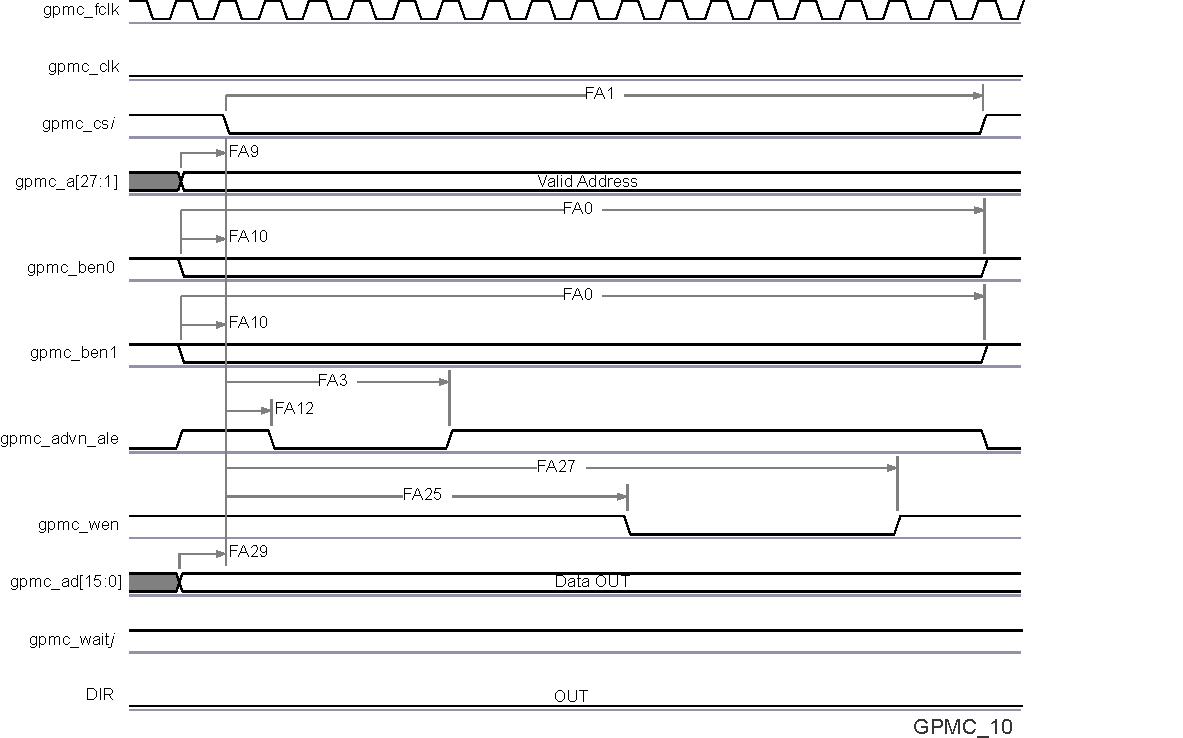 Figure 7-16 GPMC / NOR Flash - Asynchronous Write - Single Word Timing(1)
Figure 7-16 GPMC / NOR Flash - Asynchronous Write - Single Word Timing(1) - In gpmc_csi, i = 0 to 7. In gpmc_waitj, j = 0 to 1.
- The "DIR" (direction control) output signal is NOT pinned out on any of the device pads. It is an internal signal only representing a signal direction on the GPMC data bus.
- In gpmc_csi, i = 0 to 7. In gpmc_waitj, j = 0 to 1
- FA5 parameter illustrates amount of time required to internally sample input Data. It is expressed in number of GPMC functional clock cycles. From start of read cycle and after FA5 functional clock cycles, input Data will be internally sampled by active functional clock edge. FA5 value should be stored inside AccessTime register bits field.
- GPMC_FCLK is an internal clock (GPMC functional clock) not provided externally
- The "DIR" (direction control) output signal is NOT pinned out on any of the device pads. It is an internal signal only representing a signal direction on the GPMC data bus.
- In gpmc_csi, i = 0 to 7. In gpmc_waitj, j = 0 to 1.
- The "DIR" (direction control) output signal is NOT pinned out on any of the device pads. It is an internal signal only representing a signal direction on the GPMC data bus.
